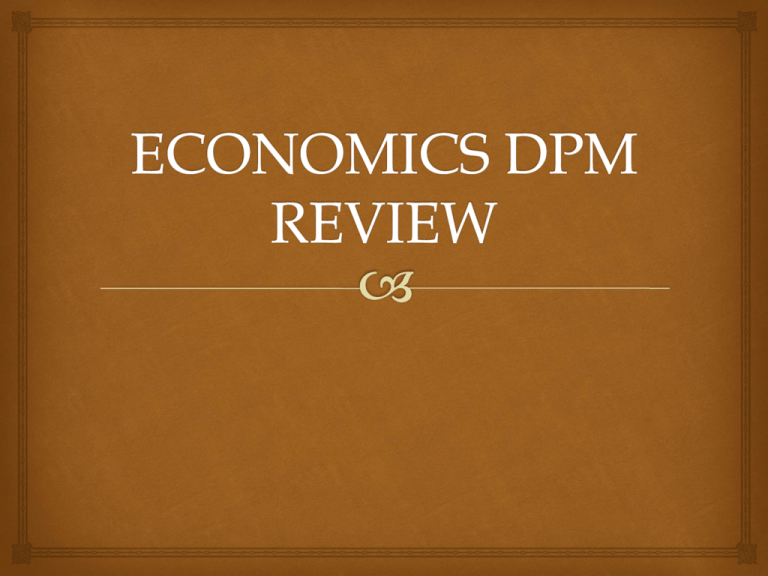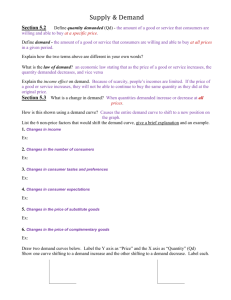ECONOMICS DPM REVIEW
advertisement

Basic Economic Ideas Scarcity is everywhere! (Unlimited needs/wants-Limited resources) When a choice is made, the opportunity cost is the value of what is given up. Therefore, all countries must make choices when answering the three economic questions. What should be produced? Who should produce them? Who will get them? The Factors of Production (FOPS): Land (natural resources) Labor (people working) Capital (things businesses use to make money) Entrepreneurship (people who invent things, for example) The PPF Shows the possible combinations of two goods that can be produced Shows scarcity and opportunity cost: make more of one, give up some of the other Points inside the curve are possible, but underutilizing resources Points outside the curve are impossible for now, but might be in the future with technology advances Supply and Demand Demand curve: shows what consumers are willing and able to buy at various prices Price goes up, quantity demanded goes down Supply curve: shows what consumers are willing and able to by at various prices. Price goes up, quantity supplied goes up Supply and Demand Markets will return to equilibrium without government interference A price of $1 will create a shortage where the quantity demanded is greater that the quantity supplied. Government imposed= price ceiling A price of $3 will create a surplus where the quantity supplied is greater than the quantity demanded Government imposed= price floor Supply and Demand Determinants Demand Curves will shift due to changes in: Taste and Preferences of consumers Income of consumers Buyers (number of) Expectations of Consumers Related goods (price of) Supplements and complements Supply Curves will shift due to changes in: Technology Other goods (price of) Number of Sellers Expectations of Firms Resource Prices Subsidies and Taxes Subsidy- “tax in reverse” Shifting Supply and Demand Curves INCREASE TO THE RIGHT DECREASE TO THE LEFT Circular Flow Model Remember: Firms purchase stuff in the factor market People purchase stuff in the product market Below: Red arrows are physical flow and green arrows are monetary flow Types of Economic Systems Command Communism Socialism Capitalism Free Market •Total amount of government interference •Large amount of government Interference •ExampleChina, North Korea •Karl Marx •Some government interference, government owns the FOPS •Market system with a amall amount of government interference •ExampleUnited States •No government interference •Adam Smith The Business Cycle Economic Indicators GDP: total dollar value of all final goods and services produced in an economy in a year (measures the growth of the US economy by calculating output of businesses in America) Types of Unemployment: Seasonal Structural Frictional Cyclical American Fiscal Policy Revenue: money taken in by the federal government, largest source of revenue- income taxes Expansionary Fiscal Policy: Government lowers taxes and increases spending (practiced during contraction in business cycle) Contractionary Fiscal Policy: Government raises taxes and decreases spending (practiced during inflationary period) The Federal Reserve Set up to regulate the US monetary policy and control the supply of American currency Tools of the FED: Discount Rate-Amount of interest The Fed charges member banks to borrow money Reserve Requirement: Percentage of deposits that member banks are forced to hold onto Open Market Operations: The Fed’s action of buying or selling US government securities Money and Trade Money is used as a unit of accounting when you compare prices of the same item at different retailers Exchange Rate: the amount of foreign currency that can be bought with US currency (effects the price of imports) Absolute Advantage/Comparative Advantage: Absolute: country/company can make more of an item than another Comparative: country/company can produce an item at a lower opportunity cost Protectionism vs Free Trade: protectionists want barriers to trade while those in favor of Free Trade do not LEVELS OF COMPETITION Thus, the MARKET STRUCTURE for an American business depends on their unique competitive situation There are 4 basic levels of competition Pure Competition Monopolistic Competition Oligopoly Pure Monopoly Personal Finance Tips for Credit Cards: Charge only what you can afford, pay your balance each month, stay away from cash advances) Which pays more interest: checking or savings account Are US Treasury Bonds typically seen as a safe investment








